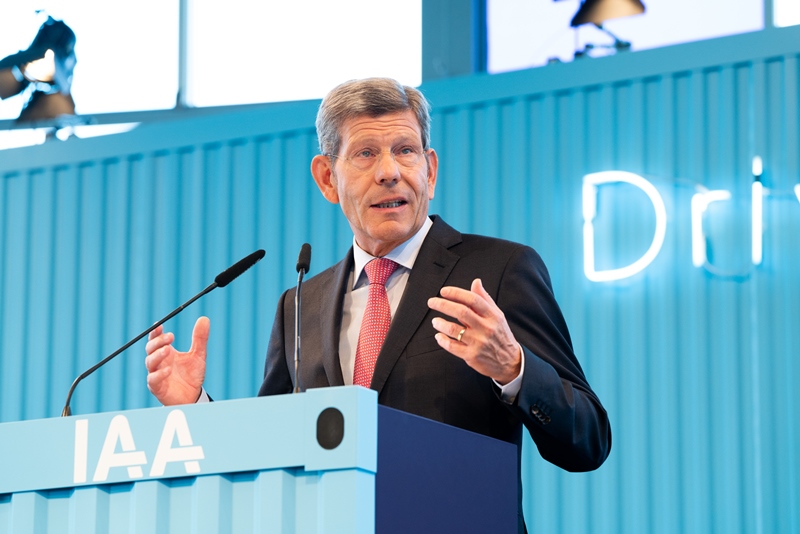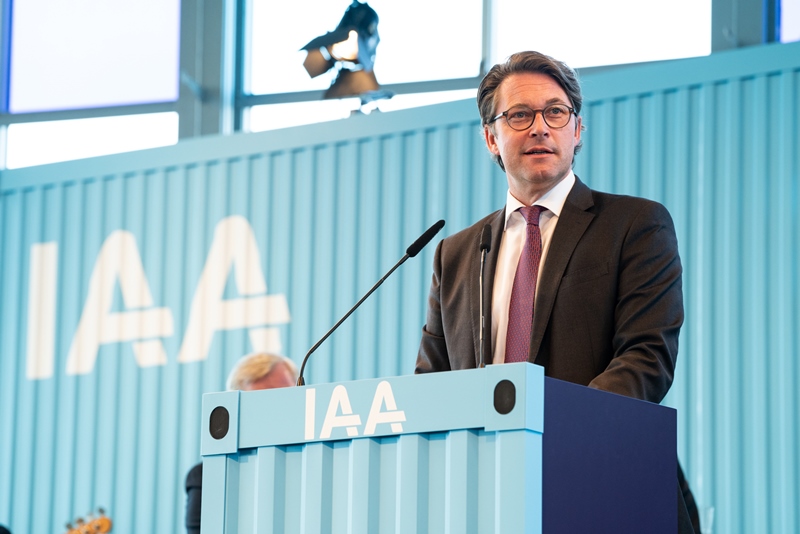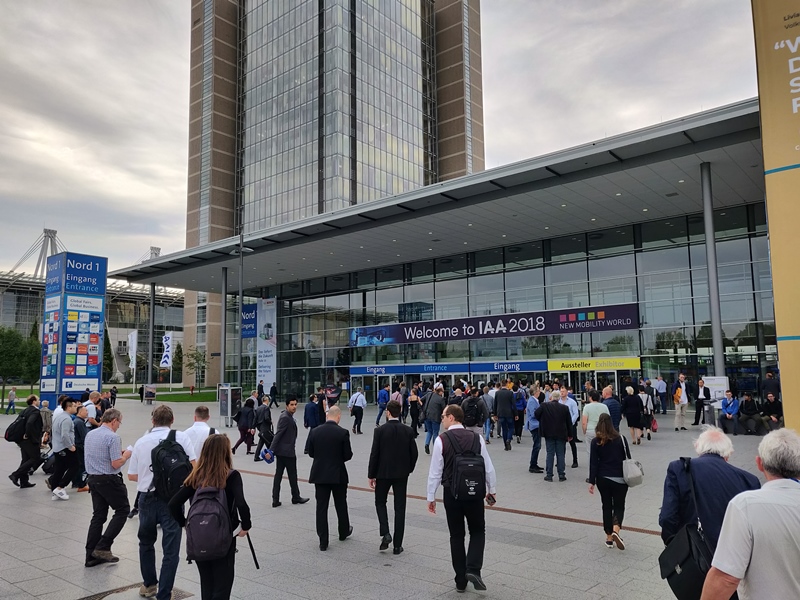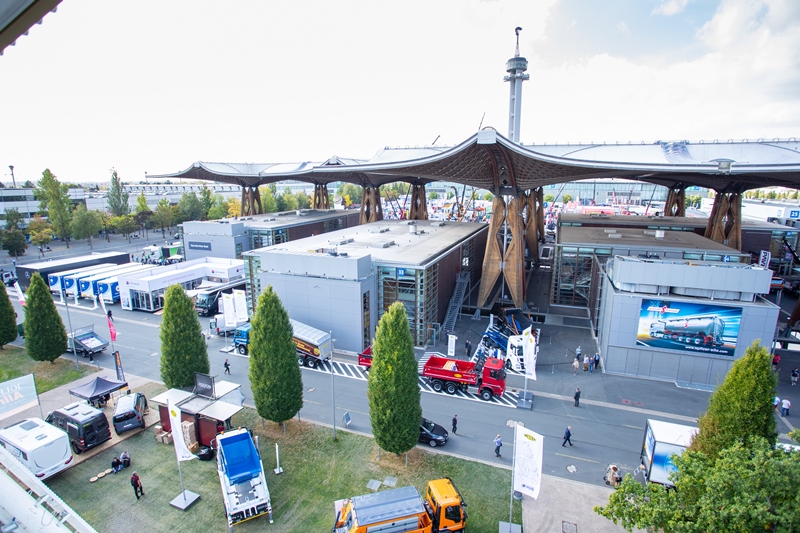“Driving tomorrow” stands for the sense of anticipation throughout CV industry – VDA President
67th IAA Commercial Vehicles opened by Federal Minister of Transport Andreas Scheuer, 600 high-ranking guests, Leading trade show for transport, logistics and mobility with more world premieres, more exhibitors and more area.
With more than 2,000 journalists from 54 countries already accredited by the Press Day (Sept. 19, 2018), the opening ceremony of the 67th IAA Commercial Vehicles took place in the Convention Center of the Hannover trade fair on Thursday. Andreas Scheuer, Federal Minister for Transport and Digital Infrastructure, opened the world’s most important trade show for transport, mobility and logistics in the presence of around 600 high-ranking guests from business, politics and society. The other speakers were Dr. Bernd Althusmann, Deputy State Premier and Minister for Economic Affairs, Labor, Transport and Digitization of the state of Lower Saxony, and Carlton Rose, President of Global Fleet Maintenance & Engineering at UPS.
In his speech Bernhard Mattes, President of the German Association of the Automotive Industry (VDA), stressed the great drive for innovation in the sector.
The speech is reproduced below.
Statement delivered by Bernhard Mattes, President of the German Association of the Automotive Industry (VDA), at the opening of the IAA Commercial Vehicles in Hannover on September 20, 2018

Honored guests from politics and business,
Friends of the industry,
Colleagues,
Ladies and Gentlemen,
I wish all of you a very warm welcome! “Driving tomorrow” is the slogan that unites us all: Being driving forces! Shaping the future! Using opportunities! Being innovative!
The commercial vehicle community and its customers are raring to go. We have many technological ideas and presentations that we wish to share with one another. That’s why we are here. We want to discuss things with one another. We want to network. As the world’s largest meeting place for the industry, you could say the IAA resembles a huge coffee bar. This is where people meet. This is where people interact. A total of 2,174 exhibitors from around 50 countries are meeting here in Hannover. More exhibitors than the last time, a truly fantastic response from the whole world. Over 280,000 square meters of exhibition space sets a new record for the IAA Commercial Vehicles.
The range of topics is broader than ever before. Digitization, connectivity, automated driving, electric mobility, alternative powertrains and urban logistics – these are our core fields. But the coffee bar should not give a false impression. The IAA has more than discussions and, more than anything, it delivers.
No other trade show offers as many innovations. The number of world premieres has risen by a good 30 percent to 435. That is also a new record and underscores the fact that the IAA is the world’s most important innovation showcase for the entire logistics chain: “Driving tomorrow”! Anyone who looks around the exhibition grounds will immediately recognize that the entire commercial vehicle industry is in a state of anticipation. Manufacturers of trucks, vans and buses, makers of trailers and bodies and the many highly specialized suppliers, startups and new service providers, they are all pursuing new paths in order to shape the transport of the future. Dear exhibitors, special thanks to all of you for coming!
The automotive industry accounts for 40 percent of all patent registrations from Germany. In this country it is the most innovative of all sectors, by a long way. At the same time, trucks cover over 70 percent of goods transport in Europe. They therefore bear a huge responsibility. Increasing flows of goods, flourishing online trade and customers’ rising demands are ONE THING. The customer is clearly at the center of attention. Yet all these demands must not adversely affect the climate, the environment or safety. That is the other thing. That is our mission. Tailor-made solutions are required. Here flexible commercial vehicles can demonstrate their strengths in full. They are and will remain the indispensible load-carriers for our prosperity.
In many places the research and development laboratories focus on digital solutions. Transport, mobility, logistics – digitization is appearing in many developments. Connectivity helps make even better use of every cubic meter of freight space – the keywords here are fleet management and logistics tools. Connectivity helps further increase cost efficiency – keyword: early maintenance messages. Connectivity helps further optimize consumption – keyword: platooning. Connectivity helps prevent congestion from arising in the first place – keywords: intelligent traffic management. Connectivity helps further improve efficiency in urban traffic – keywords: intelligent searching for parking spaces. Automation helps make road traffic even safer – keywords: emergency braking assistant and turning assistant. The vehicles can anticipate more and more, and are becoming ever more intelligent. The greatest importance is attached to data protection and data security.
The German automotive industry alone will invest around 18 billion euros in automated driving during the next three years – and of course this involves both the manufacturers and their suppliers. Nothing would work without the suppliers and their innovations. All of this points to the mobility of the future. We are bundling many of these forward-looking topics at the IAA in the New Mobility World: “Driving tomorrow”!
However, we will achieve the mobility of the future only by working together with the policymakers. Even being able to use the digital potentials on the roads requires a stable mobile telephony network with full coverage along all traffic routes. It is a good thing that the politicians are committed to this task.
Federal Minister,
We are delighted to welcome you here to Hannover today. You know the significance of transport and logistics. You have a heart for commercial vehicles. We know that you are on the side of this industry – because you too are interested in shaping the mobility of the future and mastering the transport-policy demands. You are very welcome and thank you very much for coming here today to open this IAA Commercial Vehicles.

We are also delighted that you, Minister Althusmann, are here with us today representing the host state of Lower Saxony. One month ago you presented the “Master Plan for Digitization” for your federal state. You too want to move the future. Therefore we welcome you as an important partner of the commercial vehicle industry that provides a great many jobs here in Lower Saxony.
Ladies and Gentlemen,
The mobility of the future is connected and automated and all of us want road traffic to become even more environmentally and climate friendly. All of us want our children and grandchildren to grow up in a world worth living in. You, the policymakers, therefore set ambitious targets and create incentives. We, the companies, deliver solutions. We are making our contribution.
Less consumption, less CO2, less pollution, less noise – the large metropolitan areas in particular will benefit more and more from the innovations. Smart cities promise citizens a better quality of life. Light distribution traffic and last mile logistics – they are predestined for electric mobility. Daily deployment on short, fixed routes – the ideal area for efficient, almost silent vans with electric motors and zero local emissions. They are now going into series production – this is a quantum jump. The same applies to urban buses. Here, too, we are currently experiencing an exciting market trend. In addition, think of municipal vehicles, waste collection, winter road clearance, road construction, care services and the craft trades. Alternative powertrains – including hybrids – offer ideal solutions here.
However, one thing is also clear: electric mobility is not the best choice for every application. The requirements vary too widely. You only have to think of heavy long-distance transport. So the conventional environmentally friendly powertrain will remain very important. For this reason we are continuing to drive forward the efficiency of modern diesel engines. The Euro VI standard brings another 80 percent reduction in nitrogen oxide emissions. Independent studies confirm that Euro VI heavy trucks and buses have values far below the legal limit value even in road tests.
This shows that modern diesel vehicles are clean. They can make an important contribution to complying with the EU requirements for air quality. The key to this is rapid renewal of the vehicle fleet. Diesel is an important part of “Driving tomorrow”! In addition, we are researching CO2-neutral fuels, called e-fuels. Their special advantage is that they exert their beneficial impact in the vehicles already on the roads. Natural gas is also an environmentally friendly type of powertrain, especially for commercial vehicles.
Concerning climate-policy, we have already achieved considerable progress. Since 2000, CO2 emissions per have fallen by 35 percent ton-km and the long trucks are a success history, with the makers of trailers and trucks all pulling together. Furthermore, this IAA points up the potentials that we have to tap into together to achieve even greater efficiency. Aerodynamic optimization, lightweight construction, GPS cruise control and the utilization of waste heat are important keywords here.
So under bottom line the commercial vehicle industry makes a major contribution to continuously reducing emissions. Accordingly, we also support a realistic CO2 regulation as a level playing field. However, it should be remembered that the commercial vehicle market is subject to its own conditions. The development periods and the engine and model cycles are much longer than those for passenger cars. Moreover, commercial vehicles have a large number of different bodies, each with different CO2 emission impacts. Hardly any trucks are used on the roads exactly as they roll off the production lines.
We therefore appeal to the legislators: do not try to go too far with the CO2 regulation that is being negotiated in Brussels right now. This relates first to the light commercial vehicles that are regulated along with passenger cars. But it also relates to heavy-duty commercial vehicles. Here Brussels is moving into a new territory. So far there are no values for comparison, no robust baseline. It may sound obvious to apply the proposed CO2 reduction rates for cars unchanged to the completely different sectors of light commercial vehicles and heavy trucks. But this would not take account of some important special features. Crucial potentials would remain unused.
Therefore our appeal is this: let us seek the best solutions in a manner open to all technologies-– and implement them decisively. Realistic limit values and carefully adapted incentives are the best way.
Ladies and Gentlemen,
Please allow me to finish off by touching on a topic that is important to all of us: the architecture of global trade has become unsteady over recent months. We all know that protectionism cannot be the solution for increasing prosperity. On the contrary: new trade barriers represent a major risk – to the international supply chains and to the associated value creation. Integrated and cross-border flows of goods are a valuable asset and we must do more to maintain and secure them, both businesses and policymakers. Therefore I will finish with a request to all of you in this room today: let us close ranks – and together do our utmost to promote free movement of goods and fair world trade.”

